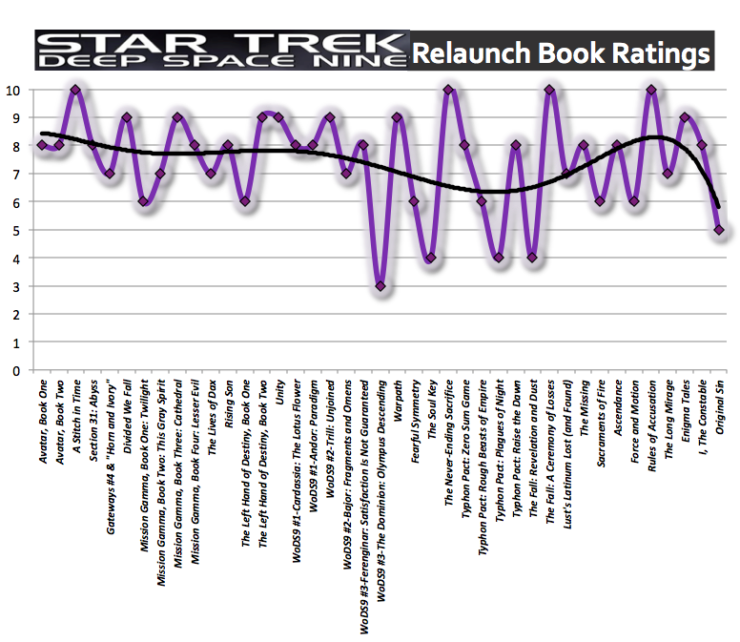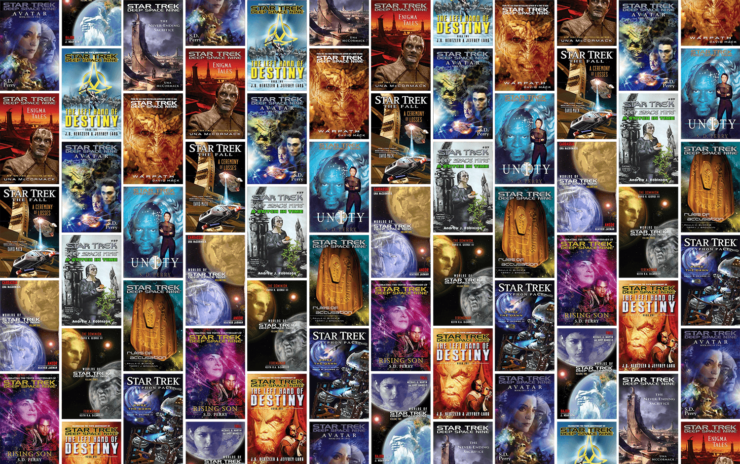Between August 7th 2019 and Feb 24th 2021 I was privileged to talk about all of the Star Trek: Deep Space Nine relaunch books (full list with linked reviews below) in this space.
It’s been an exhilarating ride, with some tremendous warp-speed intervals on state-of-the-art narratives and, let’s say, a few stretches of impulse power on second-tier vessels.
Given the scope of this review series, I thought it might be nice to (1) write a brief retrospective (2) offer up a core list of quality titles that I think can be enjoyed without much preamble and can act as gateway texts to jump into the series at various points.
Overall Impressions
This series kicks off in April 2376, four months after the television series finale, and takes us all the way through late 2386, essentially covering about a decade in the DS9 universe. (There are a couple of stories, like The Left Hand of Destiny duology, or The Never-Ending Sacrifice, that precede the starting point).
The character development, consistency of storytelling quality, and—despite an array of rotating authorial voices and approaches—the overall sense of continuity over the first 22 volumes in this series (Avatar, Book One through Warpath, based on the numbering below) is really impressive. This first half of the series contains, for me, awesome cohesion, with a cast of writers all essentially aligned on a common goal and taking turns on multi-mile relief runs adding up to an ultra-marathon. Now, as a point of interest, these 22 volumes all take place roughly (yes, there are some skips here and there) in 2375-2376. I think that helps to explain the narrative unity.
Fearful Symmetry and The Soul Key develop, in a somewhat contrived manner, story events set in motion or implied in Warpath, but I’m going to set them aside for now, principally because I’m not very fond of them.
Typhon Pact: Rough Beasts of Empire jumps forward to 2381-2382 to sync up with the broader post-Destiny litverse, and everything after this point becomes more fragmented, with several volumes, like Sacraments of Fire and Original Sin, expending considerable wordcount on filling in gaps prior to their narrative “presents.” Even reading all these latter books in the correct macro-order, the back-and-forth causes temporal whiplash, and I’m not sure I would have followed everything clearly if I hadn’t been taking notes and writing these reviews. This second “half,” loosely speaking, takes us from 2381-2386.
The ratio of time per book therefore goes from approximately one book covering about two weeks of in-universe time (excluding The Left Hand of Destiny and The Lives of Dax, the remaining first 19 books span roughly 10 months) to one book covering a little under four months of in-universe time (some 16 volumes spanning roughly 60 months). It’s actually worse than that, because the three Ferengi-centric e-book novellas are somewhat peripheral tales, which pushes up the ratio past 4 months per book for the central-sequence stories. This definitely accounts for some of the feeling of increasing detachment—events are summarized rather than experienced, and supporting cast members become harder to identify as individuals rather than names.
Nevertheless, there are still some gems to be found in this second half of the series—mostly outside of the main arc. These latter books, though, often feel like author-specific storyline or character allocations. The authorial solidarity from the first half seems largely absent. Editorial changes, business forces behind the scenes, and production schedule delays no doubt account for some of what I’ll call this feeling of dilution. The summary chart of my “orb” ratings, to which I’ve added a trendline, shows that initial consistency, followed by greater fluctuations and a slump past the mid-point.

In terms of characters, this series, when considered as a whole, contains an almost mind-boggling amount of depth and creativity. Kira, Ro, Bashir, Dax, Odo, Quark, Nog, Jake, and other TV legacy folks are provided with tremendously engaging and absorbing material. New “regulars” (even if only for certain runs of books) like Elias Vaughn, Prynn Tenmei, Shar, and Taran’atar are on a par with any of the former group in terms of richness and complexity. There are dozens and dozens of supporting characters with notable beats, as well as a host of fascinating aliens. The arc for Benjamin Sisko probably counts, for me, as the only real disappointment, but the series isn’t necessarily undermined by this, since its focus is often elsewhere anyway.
Speaking of which, we’re treated to a number of multi-book threads, including the Avatar & Ohalu prophecies (which bridges the entire series), the parasite/Trill infiltration arc, the Andorian reproductive crisis, the Typhon Pact political intrigue plotline, the evolution of the Dominion, the Alternate Universe/Iliana Ghemor/Ascendants epic, and others. Most of these are satisfyingly wrapped up or at least given plausible resting points. A few, like the Altek Dans storyline, which weaves in with the Ohalu prophecies, and the fate of Kira herself, are left open-ended.
The forthcoming Star Trek: Coda trilogy (Moments Asunder by Dayton Ward, The Ashes of Tomorrow by James Swallow, and Oblivion’s Gate by David Mack), coming out September-December of this year, seems likely to address (in perhaps a definitive manner) not only DS9-related plot questions but also those pertaining to the other key series explored in the broader litverse, clearing the way for the new Discovery/Picard/Lower Decks/Prodigy/Strange New Worlds continuity that occupies overlapping points of the timeline.
I’m hopeful, particularly since David Mack is penning the final volume, that this will bring a measure of closure or resolution to some of the narrative elements we’ve talked about in detail in volume-specific reviews of this series.
As Rugal says in The Never-Ending Sacrifice, “We are the sum of all that has gone before. We are the source of all to come.”
Core Titles
Here is my selection of fifteen key titles, and a bonus e-novella, that I think will delight any fan of the show. There are many other good books in this series, but to me these stand out for their quality and ability to tempt one into the flow of the series at different points in the chronology.
I’ve grouped them for convenience:
Avatar duology — A great place to start, introducing a set-up with enough familiarity to welcome fans of the show but also adding sufficient newness to shake things up in interesting and dramatic ways. Author S.D. Perry combines a thoughtful approach with a strong ensemble-driven plot. You may as well spring for the Twist of Faith reprint omnibus, which contains these two books plus 3 through 5 in the list below.
A Stitch in Time, The Never-Ending Sacrifice, Enigma Tales — Who doesn’t love Garak? Who wouldn’t be interested in the post-finale fate of Cardassia? The combined efforts of Andrew J. Robinson and Una McCormack deliver an outstanding elaboration and expansion of all matters Cardassian.
The Left Hand of Destiny duology — Martok, Worf, Ezri Dax, and Kahless in a blood-rousing epic inspired by Arthurian mythology.
Rising Son, Unity — I’m pairing these books together because they’re by the same author, S.D. Perry, they effectively follow one another, and the latter contains a really nice recap in its first third or so of everything of note that has come before. As with the Avatar books, these cover major events and character journeys. In hindsight, I wish more books in the second half of the series had featured Jake Sisko in a prominent way.
Worlds of Deep Space Nine trilogy — You don’t need to travel to the Gamma quadrant for the relaunch to captivate you with its worldbuilding and intricate realpolitik-flavored plotting. New insights on “familiar” worlds, and some essential moments in the overarching series plots.
Warpath, Typhon Pact: Raise the Dawn, The Fall: A Ceremony of Losses — Two thrilling contributions by David Mack, and a grand entry by David R. George III, with movement along multiple storylines. I was tempted to also include Typhon Pact: Zero Sum Game, but, as riveting as it is, in retrospect it’s not as essential as these two.
Bonus title: Rules of Accusation — Most of the above are pretty serious. This is the perfect comedic chaser.
Orb factor for the entire DS9 relaunch series: Despite a few dangling threads (possibly to be resolved in the forthcoming Coda trilogy later this year; stay tuned!) and a couple of misfires, this is a wonderful accomplishment that will keep you entertained for weeks, if not months, on end: 8 heartily-glowing orbs.

Review Index
- Avatar, Book One
- Avatar, Book Two
- A Stitch in Time
- Section 31: Abyss
- Gateways #4: Demons of Air and Darkness & “Horn and Ivory”
- Divided We Fall
- Mission Gamma, Book One: Twilight
- Mission Gamma, Book Two: This Gray Spirit
- Mission Gamma, Book Three: Cathedral
- Mission Gamma, Book Four: Lesser Evil
- The Lives of Dax
- Rising Son
- The Left Hand of Destiny, Book One
- The Left Hand of Destiny, Book Two
- Unity
- Worlds of Deep Space Nine #1—Cardassia: The Lotus Flower
- Worlds of Deep Space Nine #1—Andor: Paradigm
- Worlds of Deep Space Nine #2—Trill: Unjoined
- Worlds of Deep Space Nine #2—Bajor: Fragments and Omens
- Worlds of Deep Space Nine #3—Ferenginar: Satisfaction Is Not Guaranteed
- Worlds of Deep Space Nine #3—The Dominion: Olympus Descending
- Warpath
- Fearful Symmetry
- The Soul Key
- The Never-Ending Sacrifice
- Typhon Pact: Zero Sum Game
- Typhon Pact: Rough Beasts of Empire
- Typhon Pact: Plagues of Night
- Typhon Pact: Raise the Dawn
- The Fall: Revelation and Dust
- The Fall: A Ceremony of Losses
- Lust’s Latinum Lost (and Found)
- The Missing
- Sacraments of Fire
- Ascendance
- Force and Motion
- Rules of Accusation
- The Long Mirage
- Enigma Tales
- I, The Constable
- Original Sin
Alvaro is a Hugo- and Locus-award finalist who has published some forty stories in professional magazines and anthologies, as well as over a hundred essays, reviews, and interviews.










